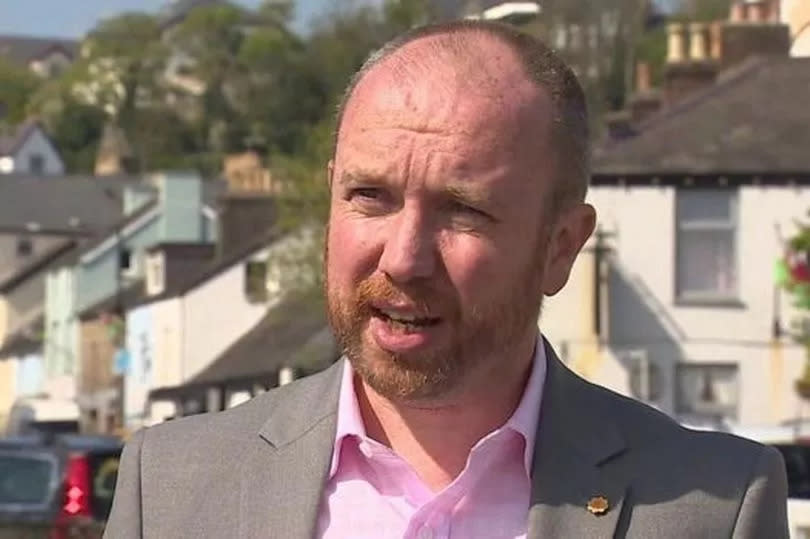'We shouldn't be building a new cancer centre on the Northern Meadows' | Mabon ap Gwynfor

The plans to build a cancer centre on Cardiff's Northern Meadows has been an ongoing controversy for years. Plaid Cymru's spokesman for health, social care and housing Mabon ap Gwynfor has written this piece where he argues there is a better alternative.
The proposed location of the new Velindre Cancer Centre on Cardiff's cherished Northern Meadows has sparked significant controversy. While a state-of-the-art cancer facility is undeniably needed, it is doubtful whether the current proposals meets the needs of a fast-evolving cancer care service while at the same time sacrificing valuable green space.
The new centre aims to replace the outdated Velindre Cancer Centre that was built in 1956. It promises to provide modern facilities, treat more patients, and advance cancer research in Wales.
The chosen site is a 14.5-hectare undeveloped area on the Northern Meadows, which is NHS-owned land.
READ MORE: Can we afford a bank holiday to celebrate our patron saint's day?
READ MORE: Vaughan Gething's terrible answer when asked about the £200k donation to his campaign
Residents' groups have raised concerns about the development's impact on the green space and argue for alternative locations like co-locating with an existing hospital.
There are also questions about the project's futureproofing in light of evolving cancer treatment methods.
The current Velindre facility struggles to meet the demands of contemporary cancer care. Outdated infrastructure restricts the implementation of life-saving technologies. Proponents of the Meadows site emphasize the urgency. However, building a standalone facility disregards the established benefits of co-location.
Cancer research and treatment is changing rapidly, and those developments require a minority of patients to be as near as possible to an acute hospital where they could receive the necessary intensive and clinical care if required. These procedures include cellular therapies such as CAR T-cell therapy and other therapies that sees immune systems being re-engineered and can be toxic. This is the cutting edge of cancer treatment and should be provided to patients who could easily be transferred to an ITU if required without having to wait long life-threatening minutes for an ambulance to transfer them to a hospital on the other side of the city.

The fall-back position for those who want to see the proposed Velindre model developed is to claim that a Nuffield report written by eminent experts supported the proposals. This, however, is incorrect. The context of that report was to ask how someone would make a success of the centre on the proposed new site. This is, of course, different to asking whether or not the proposed plan was the best plan available, to which the answer would be 'no'.
Velindre is a hugely significant centre for the whole of south Wales, treating huge numbers of people annually. It therefore needs to be the right design in the right place.
Ask any oncologist what their expectation would be of a new super-duper cancer centre and they will tell you that the first thing they would expect was for it to be placed near a major hospital that provides services such as intensive imaging, gastroenterology, cardiology or other services, so that in the most dangerous cases the consequences of the cancer or the cancer treatment can be dealt with immediately and efficiently on site.
This isn't a hunch. A letter from more than 30 senior members of clinical staff within Velindre raising concerns about the proposed 'stand-alone' clinical model for the new Velindre Cancer Centre was sent to the then Health Minister, Vaughan Gething, in July 2020. In it they stated:
"We believe that the currently proposed model of a stand-alone cancer hospital, remote from key professional colleagues, cannot adequately meet the key requirements of the modern, world-class, comprehensive cancer centre that the population of South East Wales deserves."
Not only will the 'stand-alone’ model put patients at greater danger but it will also hamper Cardiff's ability to be at the forefront of cutting-edge cancer research. The letter goes on to say:
"...our ability to continue delivering world-leading clinical research involving increasing numbers of emerging state-of-the-art treatments will be significantly limited if we are not co-located with appropriate facilities. Systemic therapies, and innovative drug-radiotherapy, vaccine and early phase clinical research, now routinely mandate immediate access to high dependency and intensive care input".
A new centre doesn't have to have a large footprint, like Clatterbridge in Liverpool for instance. Cancer treatment is changing, and across the world treatment is now being delivered closer to home. In remoter parts of Scotland, for instance, patients often receive chemotherapy at primary care surgeries, with the high-risk patients going to hospital at Inverness for treatment.
There is no one-size-fits-all model and we need to find a model that suits the demography and geography of south Wales.
To be fair the current Velindre proposals proposes more of a regional delivery model, which is certainly the correct direction of travel. But for such a model to work well and properly it would require a small unit as part of an acute hospital with access to ITU and other critical care services. This would then allow for one, two or maybe three smaller satellite treatment centres to be developed elsewhere across south Wales.
When you consider that the number of people requiring treatment is expected to increase significantly over the coming years then it would make sense to provide as much treatment as possible closer to where they live, with the acutely ill patients visiting the central Velindre hub with access to critical care and novel therapies.
I recently visited the Clatterbridge Cancer centre in Liverpool - a wonderful state-of-the-art centre that serves the needs of north Wales that moved from the original Aintree site on the Wirral to Liverpool in 2020 - and spoke to some of those that developed the centre. They've developed a regional model there, with non-surgery oncology such as chemotherapy or radiotherapy being delivered at the original site at Aintree, on the Wirral, and Ormiskirk Hospital as well as other sites delivering other services. But locating Clatterbridge Centre itself next to the Royal Liverpool Hospital allows them to provide treatments such as haemato-oncology, where the patient is more prone to rapid deterioration and needs close access to ITU.
The fact that they are also placed in the heart of what they refer to as the Knowledge Quarter, surrounded by university departments and research units, has meant that they are now attracting world class researchers. Their proximity to an acute hospital allows them to conduct research that would never have been achieved at the original Clatterbridge Centre on the Wirral.
If we are to provide the best care with world-leading research then co-locating with an acute hospital, such as the Heath, is essential.
Co-locating a new Velindre with an existing acute hospital presents numerous advantages, not least that it has the benefit of integrating cancer care with other specialties, fostering seamless collaboration between oncologists, surgeons, and other specialists.
Co-location facilitates quicker access to vital diagnostic tools and specialists from various disciplines, leading to swifter diagnoses and the initiation of treatment. Delays can be crucial in cancer care, and co-location minimises these.
A shared environment fosters robust research collaborations.
Cancer treatment often involves a combination of therapies. Co-location simplifies communication between oncologists, radiologists, nurses, and other healthcare professionals, resulting in more holistic, patient-centred care plans.
And co-location fosters closer collaboration between researchers and clinicians.
Finally, it's worth referencing the proposed site for the new centre. The Northern Meadows hold immense value. They provide a vital green lung for Cardiff, essential for physical and mental well-being. Studies have linked access to green space with improved patient outcomes. Building on the Meadows would deprive patients and city residents of this crucial resource.
There are alternative sites for the new Velindre. Existing NHS facilities with space for expansion could be considered, as well as developing a model which allows for satellites to be developed in other centres across south Wales. This approach would ensure both the preservation of green space and optimal patient care.
The need for a new Velindre Cancer Centre is undeniable. A co-located centre with satellite units closer to the patients would provide superior patient care, facilitate research integration, and preserve Cardiff's green space.

 Yahoo News
Yahoo News 
